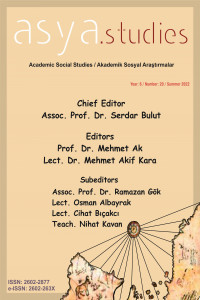TIRSÎ DÎVÂNI’NDA ÇİNGENELER
Şair, kendi döneminin ve toplumunun adamı olması dolayısıyla ister istemez kendi sosyal çevresini şiirlerine yanısıtır. Bu nedenle bütün divanlarda toplumsal konularla ilgili malzeme bulunabileceğini söyleyebiliriz; ancak bazı divanlarda sözkonusu malzemeler diğer divanlara nisbetle oldukça fazladır. Tırsî Divanı bunlardan biridir. 18. yüzyıl şairlerinden Tırsî, toplumsal çevresini, günlük yaşamı ve o dönemin kültürünü yansıtan pek çok beyit yazmıştır. Giyim kuşamdan yemeklere, müzikten mesleklere pek çok konuya değinmiştir. Bu konulardan biri de çingenelerdir. Şair, sosyal çevresinde şahit olduğu olaylardan ve toplumun algılarından yola çıkarak zihninde bir çingene imgesi oluşturmuş ve bunu şiirlerine alaycı ve esprili bir üslupla yansıtmıştır. Ona göre çingeneler, orucu kuru ekmekle tutacak kadar fakirdir; hamamdan peştamalı çalacak kadar hırsız ve güvenilmezdir. Çadırlarda yaşarlar, bakla falı bakarlar. Alışverişte sahtekardırlar, kavgada ise korkaktırlar. Ağızları bozuktur, sefil bir hayat yaşarlar. Bildirimizde amacımız, sosyal meselelerin divan şiirine nasıl yansıdığını Tırsî Divanı örneğinde ve çingeneler konusu çerçevesinde göstermektir. İncelememiz, Tırsî Divanı’nda çingane, çingan, çingene ve kıptî kelimelerini tarayarak ulaştığımız 19 beyit üzerinde olacaktır. Bulgularımızı altı başlıkta inceleyeceğiz: 1) Fakirlik, 2) Falcılık, 3) Güvenilmezlik, 4) Korkaklık, 5) Tırsî’nin Çingeneliği, 6) Diğer.
Anahtar Kelimeler:
Tırsî, çingeneler, divan şiiri, kültür, sosyal hayat
GYPSIES IN THE DIVAN OF TIRSÎ
Since the poet is the man of his time and society, he inevitably responds to his social circle. In other words, the poem carries the traces of the culture in which it is formed. Classical Turkish poetry cannot be excluded from this general rule. Therefore, we can say that all divans have material related to social and cultural issues; however, in some divans, these materials are considerably higher than other divans. Tırsî’s Divan is one of them.İbrahim Tırsi, one of the 18th century poets, wrote many couplets reflecting the social environment, daily life and the culture of that period in the poems in his Divan. Clothing has touched on many subjects from food to food, from music to professions. One of these issues is the gypsies.The poet, based on the events he witnessed in the social environment and the perceptions of the society, created an image of a gypsy and reflected it in a sarcastic and humorous style. According to him, the Gypsies are poor enough to hold the fast with dry bread; thieves and unreliable to play from the bath. They live in tents. They are fraudulent in shopping, they are cowardly in fighting. They have a bad life, live a miserable life. In our article, our aim is to show how social issues are reflected in divan poetry in the context of Tırsî Divanı and gypsies. Our review will be on 19 couplets that we have reached by scanning the words of gypsy, gypsy, and gypsy in the Tırsi Court. We will examine our findings in six chapters: 1) Poverty, 2) Fortune telling, 3) Unreliability, 4) Cowardice, 5) Gypsyness of the Tarsi, 6) Other.
Keywords:
Tırsî, Gypsies, Divan Poetry, Culture, Social Life,
___
- AnaBritannica Genel Kültür Ansiklopedisi (1994), Ana Yayıncılık A.Ş. Ve Encyclopaeida Britannica Inc. , Cilt 9, İstanbul
- Berger, H. (2000); Çingene Mitolojisi, Ayraç Yayınevi, Ankara
- Şemseddin Sami (2015); Kamus-ı Türkî, TDK Yayınları, Ankara
- Toven, B. M. (2015); Yeni Türkçe Lügat, TDK Yayınları, Ankara
- Ünaldı, H. (2012); ‘Türkiye’de Yaşayan Kültürel Bir Farklılık: Çingeneler’, Batman Üniversitesi Yaşam Bilimleri Dergisi, Cilt: 1, Sayı: 1, sayfa: 615-626
- Yılmaz, K. (t.y.); İbrahim Tırsî ve Dîvânı (İnceleme-Tenkidli Metin), http://ekitap.kulturturizm.gov.tr/Eklenti/55911,ibrahim-tirsi-ve-divanipdf.pdf?0 (Erişim Tarihi: 07.12.2017)
- ISSN: 2602-2877
- Yayın Aralığı: Yılda 4 Sayı
- Başlangıç: 2017
- Yayıncı: Mehmet Akif KARA
